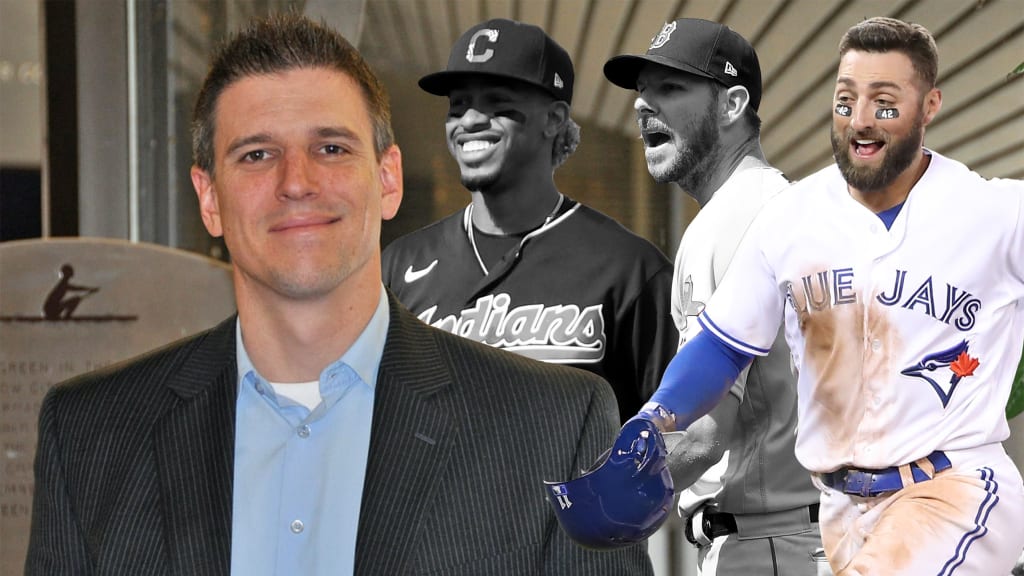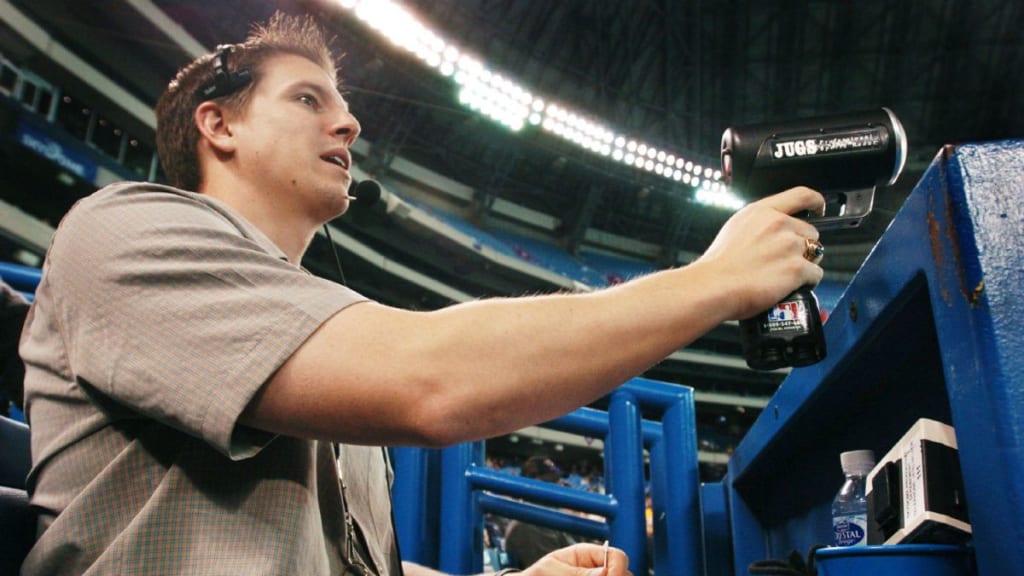
While we wait for the baseball season to get underway and for scouts to get back out on the road for their respective organizations, MLB Pipeline will shine a spotlight on these hard-working evaluators who are typically behind the scenes. We’ll talk to scouts across the game about their best Draft picks, biggest misses, best stories, go-to road food and more.
By the time Andrew Tinnish was ready to head out into the working world, he knew he wanted to scout.
Tinnish had already spent some time picking the brains of coaches and evaluators he would come across as a young player and fan, and after Blue Jays scout -- and his former coach -- Kevin Briand came to speak to his sport management class at Brock University in 1999, Tinnish reached out to see if any opportunities might be available.
Briand and the Blue Jays had just started implementing a tour of camps and clinics for young players across Ontario, and he happened to have room for a helping hand.
“I would drive around, we would go to Sudbury, Windsor, Mississauga, Ottawa, and we’d run instructional clinics and tryout camps,” Tinnish said. “I’d just throw a bunch of batting practice, and that was my introduction into it. Kevin had these old cards and he’d write up little notes and I’d pick his brain. That was where the foundation started.”
In 2001, Tinnish began working for the Blue Jays before eventually being hired full-time by the club. Toronto sent him to Major League Baseball’s scout school in ’02 and he became an area scout the following year before returning to the office in Toronto to take on an array of roles in the years that followed. The 44-year-old is currently the VP of international scouting.
Biggest standout
“Francisco Lindor was one of the most impressive high school players I ever saw,” Tinnish said. “We pretty much knew that we weren’t going to get him [the Blue Jays had the No. 21 in the 2011 Draft] but you still go see the player and make your evaluation. And it was not very common to see a player, especially defensively -- a high school defender at a premium position -- not make any mistakes or come close to making any mistakes over the course of the time scouting him.
“That was one of the most impressive things I had ever seen. He had a fielding routine he had developed, that he worked on and did pregame, and at one point he’s taking 30 ground balls with his throwing arm behind his back, fielding balls out front with just his glove hand. The ability to use his feet and his glove hand to make plays was unbelievable. I don’t know if I’ve ever seen anyone else do that.
“Perfect is a strong term to use, but he was so impressive and advanced and you’re thinking, ‘This kid is 17 years old and he’s probably better than an average Major League defender right now.’”
Biggest miss
“We passed on Chris Sale,” Tinnish said of the 2010 Draft, a time when he was Toronto’s amateur scouting director. “I didn’t see the elite side. I saw a lean, wiry guy who was 88-92, who threw strikes, but I didn’t see a guy who was going to be nearly this dominant and durable. I know he just got Tommy John, but he’s had an unbelievable career.
“I didn’t see that coming for him at all. I thought he was definitely a big leaguer, but not to this extent. … I certainly overlooked the level of competitiveness, which is just off the charts, and probably also degrees of flexibility and athleticism that are also off the charts, allowing him to do what he does year in and year out.”
Best story
“[Kevin] Pillar’s an easy one,” Tinnish said. “He’s such an animal, such a competitor, such a hard worker. He’s undrafted as a junior in a year he had a 54-game hitting streak, went unrecruited by D-I schools out of high school, always kind of had a chip on his shoulder. We had a first year area scout, Kevin Fox -- who’s with the Mariners now -- and Gerrit Cole and Trevor Bauer were in his area at UCLA, and I remember walking out of Kevin’s regional meeting and thinking, ‘Man, this guy really wants Kevin Pillar.’ I think he knew Cole would be gone, Bauer’s gone, and obviously they were on his [preference] list, but that’s what resonated most.
“It’s funny, in the Draft room, our regional crosschecker at the time Tim Rooney came up to me a couple times to remind me. We’re getting later in the Draft and he’s saying, ‘Pillar, hey, Pillar,’ and it was around the 30th round when he said it. Then the 32nd round started and I heard, ‘Cal State Dominguez Hills,’ and I thought we lost him. I freaked out.
“It wasn’t him. His teammate Carlos Leyva was drafted with pick 972. Rooney looked at me and I was like, ‘OK, OK, we’re taking him now,’ so we took Pillar with pick No. 979. It was one of those moments that takes your breath away. … I don’t know exactly why it took so long. It did. I think we felt like there weren’t teams on him. I’m just thankful that we got him.”
Go-to road food
“When I was an area scout and a coordinator, it was a lot of Boston Market and Firehouse Subs. If I’m out on the West Coast, In-N-Out Burger, I’m always there, 4x4 protein style with pickles and mustard is my go-to, with a chocolate shake. Pretty much everywhere I go, I’ll try and find the best little local spot.”

Favourite ballpark
“I always liked Pepperdine. Out in Malibu you can set up in the hills a little bit overlooking the Pacific. It’s tough to beat that view. I always liked University of Auburn, that has a little Fenway-ish replica with the wall, how it’s set up. University of South Carolina has a beautiful park too.”
Advice to industry hopefuls
“No. 1, know tech -- understand how to interpret data and use things like Rapsodo, TrackMan, Edgertronic cameras, because there’s so much information we can gather from these types of things that you can’t pick up with the naked eye at regular speed. Understand the analytics component, being able to use programs like SQL, Python, R, ways to quickly search data. Language is important too … and understanding swing and pitching mechanics, actually how the body is sequenced and moves through a delivery or a swing, what works and what puts a player at high risk.”
